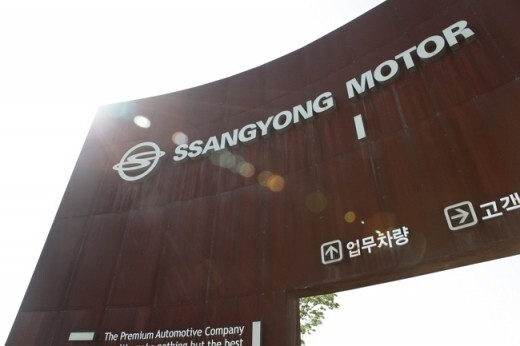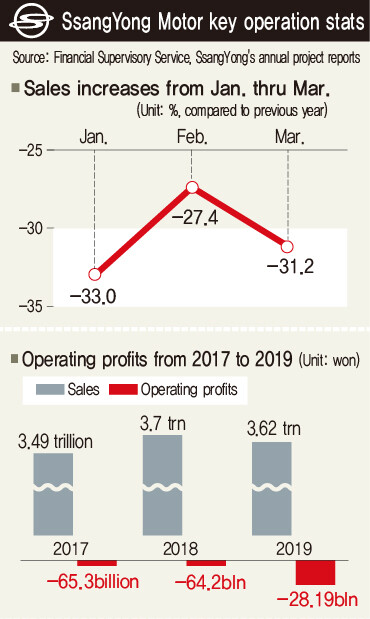
SsangYong Motor headquarters in Pyeongtaek, Gyeonggi Province. (provided by SsangYong Motor)
India’s Mahindra (M&M) Group, the largest stockholder in SsangYong Motor, said the automaker will have to find its own path to survival, in what amounts to an abdication of the group’s responsibilities as majority stockholder. While Mahindra had earlier promised to inject 230 billion won (US$186.74 million) of capital into SsangYong, conditions overseas have been worsened by factors such as the COVID-19 pandemic, causing the group to abandon its bailout plans. Nine years after its acquisition by Mahindra in 2011, SsangYong, with its 5,000 employees, once again stands at a crucial fork in the road, with recovery lying in one direction and bankruptcy in the other.
Mahindra’s decision to adjust its bailout plan for SsangYong became known in South Korea at 11 pm on Apr. 3. The news was broken not by the automaker itself but by a local PR firm that had recently signed a contract with Mahindra. While bypassing the automaker in the announcement process was unusual enough, the information being announced was just as shocking.

SsangYong Motor key operation stats
In the press release, Mahindra said it had held a “special meeting” of its board of directors “to discuss the approach to capital allocation in light of the COVID 19 impact.”
“After lengthy deliberation given the current and projected cash flows, the M&M Board took a decision that M&M will not be able to inject any fresh equity” into SsangYong. “However, with a view to enable [SsangYong] to have continuity of business operations, whilst they are exploring alternate sources of funding, the board has authorized the M&M management to consider a special one-time infusion of up to 40 billion won (US$ 32 million) over the next three months,” the group said.
In effect, Mahindra is setting aside its obligations as majority shareholder in SsangYong (as of December 2019, it held a 74.7% stake in the automaker). After extending several hundred billion won in additional loans last year, Mahindra had announced a plan to provide 230 billion won for SsangYong’s sustainable development in a board meeting in February and asked the Korea Development Bank (KDB) to provide a comparable amount of aid.
India’s economic growth has slowed considerably since 2016
The reason that Mahindra has changed its stance and cut SsangYong loose to sink or swim is because the group has reached a point where it no longer has the resources to keep the automaker going. While the group has a presence in various industries, including IT, finance, and even aerospace, 96% of its total revenue derives from its automobile and farm machinery divisions. Most of its sales are made domestically in India.
The problem is that India’s economic growth has slowed considerably since 2016. The economic growth rate has fallen by a point each year, reaching 4% in the fourth quarter of 2019. The spread of COVID-19 has made matters even worse, intensifying financial pressure on Mahindra. In a recent report, the Asian Development Bank (ADB) said that India’s yearly growth rate would fall to about 4% this year. ICRA, a local affiliate of Moody’s, predicted that India would see growth of 2.4% in the first quarter. Last month, Reuters and other foreign media reported that Mahindra’s automobile sales in India had fallen by 88% year on year.
Another likely factor behind Mahindra’s decision is that SsangYong has not been a money-making affiliate for the group. Aside from 2016, SsangYong has posted a loss in each of the eight years since it was acquired by Mahindra. Last year, its operating losses exceeded 280 billion won (US$227.26 million).
SsangYong unlikely to survive unless another investor steps in
Without additional help from Mahindra or elsewhere, SsangYong is unlikely to survive. As of the end of December 2019, the company had 120 billion won (US$97.4 million) in cash holdings, less than one-third of the 430 billion won (US$349.05 million) paid in wages to its employees last year. The company is also under obligation to pay back 254 billion (US$206.19 million) in loans that are maturing this year. Barring a sudden boom in car sales, a liquidity crisis is inevitable. For three consecutive months this year, SsangYong’s sales (including partially assembled goods) have been about 30% lower than the same period last year.
Experts believe that the company is in serious trouble unless a new investor shows up to take Mahindra’s place or the KDB, SsangYong’s main creditor, becomes its majority stockholder through a debt-equity swap or capital infusion. Essentially, this means that the automaker’s fate rests in the hands of the government.
“The KDB had been looking into aid packages for SsangYong on the assumption that Mahindra would be injecting more capital. [Since the situation has changed,] we’ll have to reset the board. Its [loans] won’t be coming due for a while yet, so there’s still time to look over our options,” a senior official in the government said in a phone call with the Hankyoreh.
“We’re likely to see a string of conglomerates in the same difficulties as SsangYong [because of the economic shock of COVID-19], and we need to think about whether it’s wise for KDB to step in every time that happens,” the official added.
A spokesperson for the SsangYong union said that the union would release a position statement around Apr. 7, after making some further inquiries. As of the end of 2019, there were 5,040 people on the payroll at SsangYong (not including outside directors).
By Kim Kyung-rak, Park Su-ji, and Seon Dam-eun, staff reporters
Please direct comments or questions to [english@hani.co.kr]





